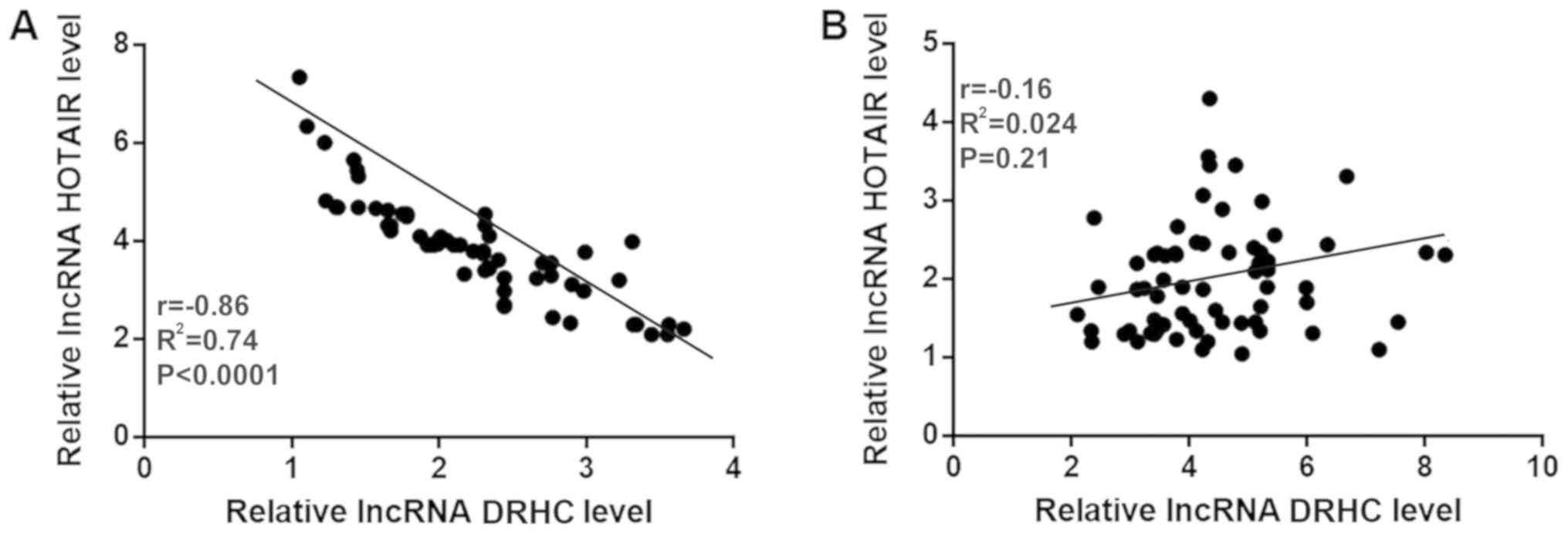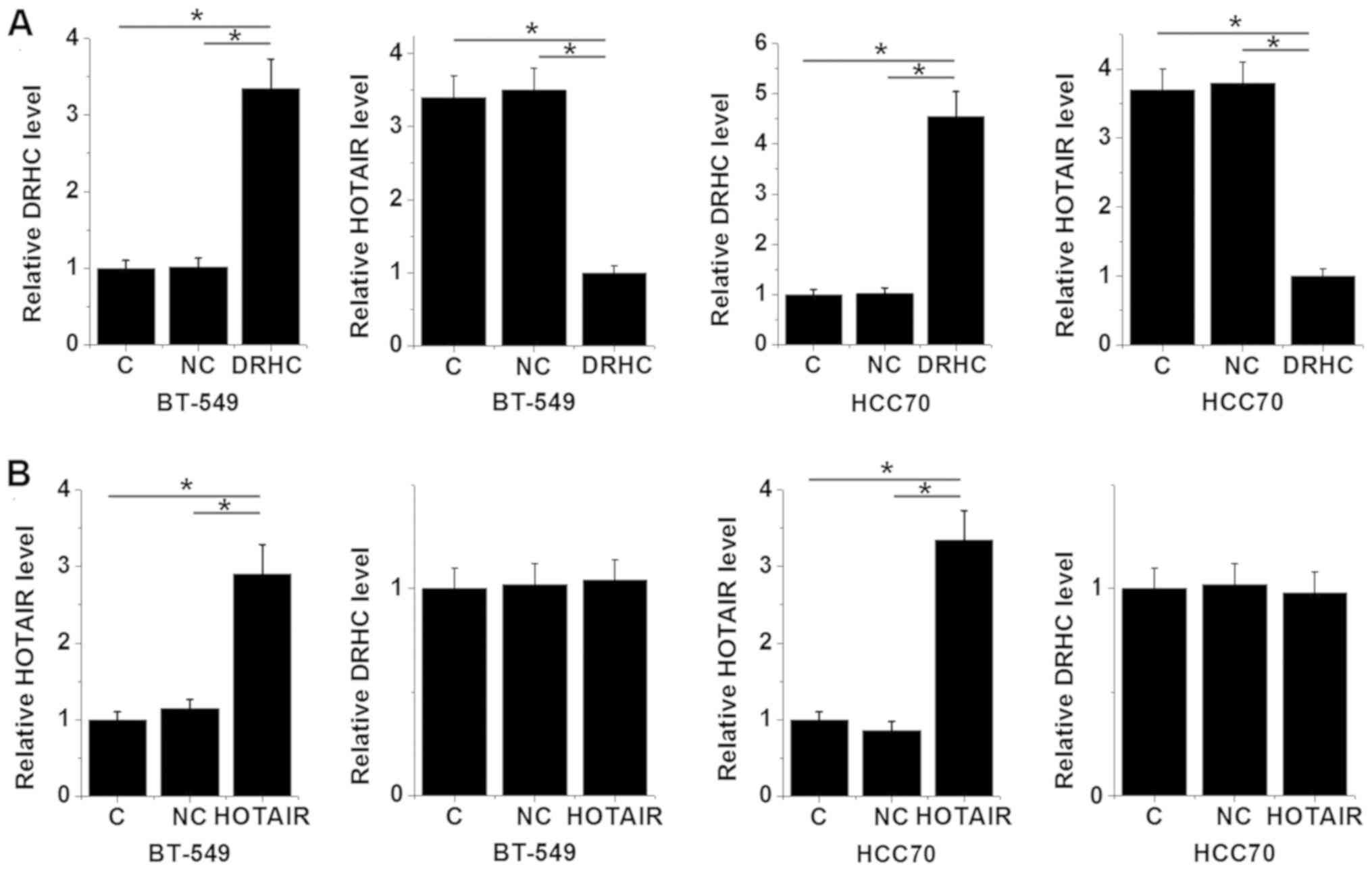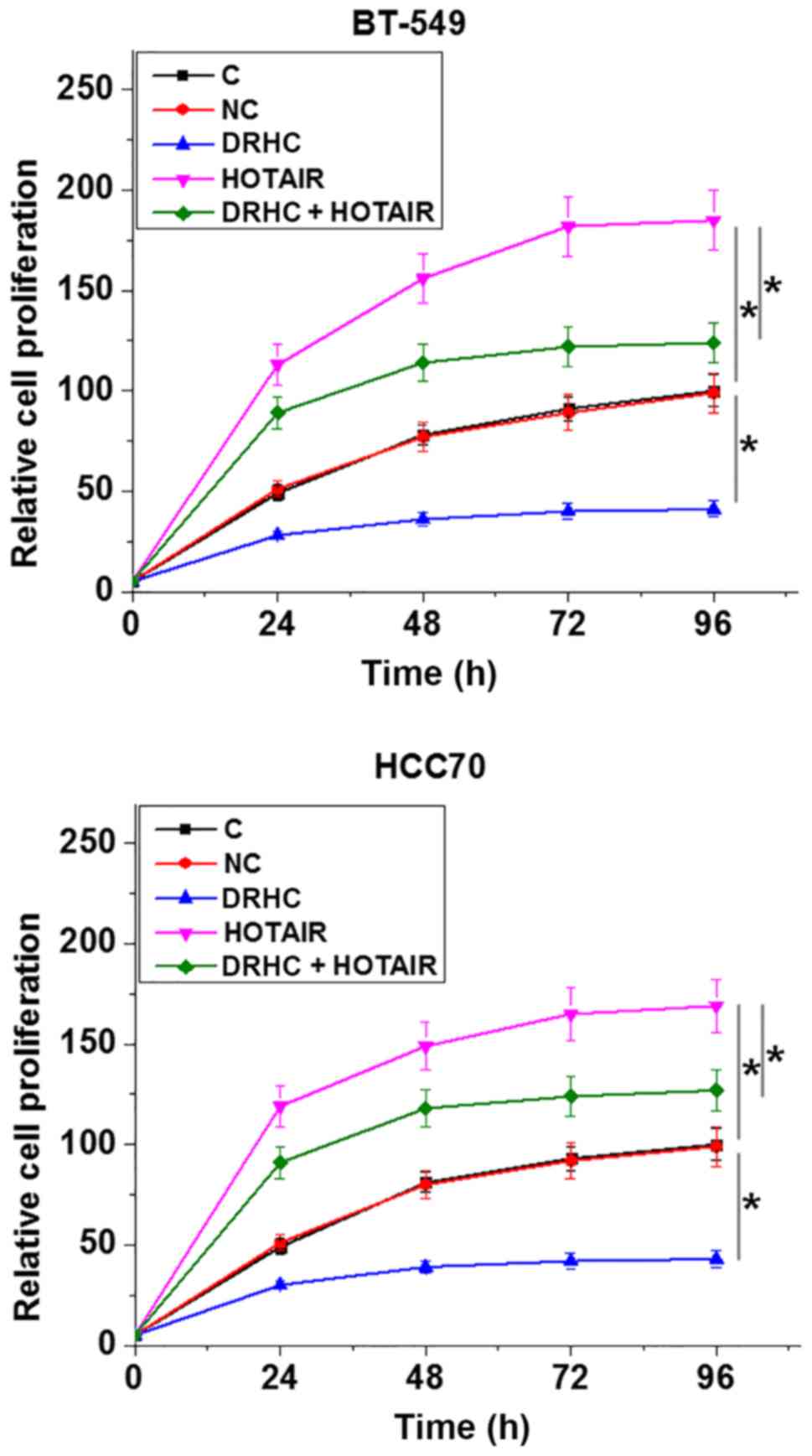Introduction
As the most commonly diagnosed malignancy in
females, breast cancer is the second leading cause of
cancer-associated mortalities among female patients (1,2).
Triple-negative breast cancer (TNBC) is characterized by the
absence of the estrogen and progesterone receptors and erb-b2
receptor tyrosine kinase 2 (3).
Chemotherapy remains the primary treatment option for patients with
early and advanced TNBC (4).
However, the lack of targeted therapies usually leads to poor
prognosis (5). At present, the
identification of a molecular target for the treatment of TNBC
remains challenging.
Long non-coding RNAs (lncRNAs) are a group of
non-protein coding RNA transcripts composed of >200 nucleotides
(6). While messenger RNAs serve as
mediators between DNA and protein, lncRNAs participate in cell
growth and development directly in the form of RNA (7). lncRNAs encode no protein products but
regulate gene expression at multiple levels (7). Therefore, regulation of lncRNA
expression may indirectly regulate the expression of downstream
genes that may serve roles in pathological or physiological
processes (7–9). Previous studies demonstrated that
lncRNAs are essential players in the pathogenesis of human
diseases, particularly different types of human cancer (8,9).
Therefore, lncRNAs may be promising therapeutic targets for the
treatment of cancer (8,9). lncRNA Hox transcript antisense RNA
(HOTAIR) is a well-characterized oncogenic lncRNA in several types
of cancer (10). lncRNA DRHC has
been recently reported to be a tumor suppressor in liver cancer
(11); however, its role in other
types of human cancer remains unknown. The present study revealed
that lncRNA DRHC was downregulated in TNBC patients and inhibited
the proliferation of TNBC cancer cells, possibly through
downregulation of lncRNA HOTAIR.
Materials and methods
Patient samples
A total of 68 female patients with TNBC were
enrolled in the Heilongjiang Farms and Land General Hospital
(Haerbin, China) between April 2016 and July 2018. The inclusion
criteria were as follows: i) Patients diagnosed by
histopathological biopsies; ii) patients with complete medical
records; and iii) patients who were willing to participate in the
study. The exclusion criteria were as follows: i) Patients with
other types of malignancies; ii) patients with chronic disease; and
iii) patients who were treated within three months prior to
admission. All patients received breast biopsies and tumor tissue
as well as healthy adjacent tissue samples were obtained from each
patient. The age of patients ranged between 32 and 66 years
(median, 49 years; mean ± standard deviation, 48.6±5.7 years). The
patients included 13 cases at stage I, 22 cases at stage II, 16
cases at stage III and 17 cases at stage IV. Tumor size was
determined by performing magnetic resonance or X-ray imaging.
Patients were divided into groups according to tumor size: i) 0–2
cm (n=19); ii) 2–5 cm (n=30); and iii) >5 cm (n=19). Patients
were divided into groups according to the absence or presence of
metastasis: i) Non-metastasis group (n=30); and ii) metastasis
group (n=38). The Ethics Committee of Heilongjiang Farms & Land
General Hospital approved the present study prior to enrolment of
patients. All patients signed informed consent.
Cell lines
The present study included two TNBC cell lines,
BT-549 and HCC70. The two cell lines were purchased from the
American Type Culture Collection (ATCC). Cells were cultured using
RPMI-1640 medium (ATCC) supplemented with 10% fetal bovine serum,
1% Penicillin and Streptomycin (all from Sangon Biotech Co., Ltd.)
at 37°C with 5% CO2.
Reverse-transcription quantitative
polymerase chain reaction (RT-qPCR)
In order to detect the expression of lncRNA DRHC and
lncRNA HOTAIR in both in vitro cultivated TNBC cells and
tissue samples from TNBC patients, the RNeasy Mini kit (Qiagen
GmbH) was used to extract total RNA, according to the
manufacturer's instructions. The Applied Biosystems™ High-Capacity
cDNA Reverse Transcription kit (Applied Biosystems; Thermo Fisher
Scientific, Inc., Waltham, MA, USA) was used to perform reverse
transcription (25°C for 5 min, 55°C for 20 min and 75°C for 10
min). The qScript One-Step RT-qPCR kit (Quantabio) was used to
perform qPCR, according to the manufacturer's protocol. All qPCR
reactions were performed using an ABI 7500 system. lncRNA DRHC,
lncRNA HOTAIR and GAPDH endogenous control primer pairs were
designed and synthesized by Shanghai GenePharma Co., Ltd. The
following primer sequences were used: lncRNA DRHC forward,
5′-GCTTAGAAATTTCTTCCACCTG-3′; lncRNA DRHC reverse,
5′-CTGCCCTAGCGATTTGTGAA-3′; lncRNA HOTAIR forward,
5′-CAGTGGGGAACTCTGACTCG-3′; lncRNA HOTAIR reverse,
5′-GTGCCTGGTGCTCTCTTACC-3′; GAPDH forward, 5′-GTCTCCTCTGACTTCAA-3′;
and GAPDH reverse, 5′-ACCACCCTGTTGCTGTA-3′. The following
thermocycling conditions were used: 95°C for 2 min, followed by 40
cycles of 95°C for 10 sec and 55°C for 30 sec. The expression of
lncRNA DRHC and lncRNA HOTAIR was normalized to GAPDH endogenous
control using the 2−ΔΔCq method (12). The sample with the lowest expression
level was set to ‘1’ and all other samples were normalized to this
sample.
Cell transfection
Vectors expressing lncRNA DRHC (11) or lncRNA HOTAIR (NR_047517.1) as well
as the empty pcDNA3.1 vector were purchased from Sangon Biotech
Co., Ltd. BT-549 and HCC70 cell lines were cultured overnight to
reach 70–80% confluence. Vectors (10 nM) were transfected into
cells using Lipofectamine® 2000 (cat. no. 11668-019;
Invitrogen; Thermo Fisher Scientific, Inc.). Cells treated with
Lipofectamine 2000 but without vectors were used as control (C)
cells. Cells transfected with empty vectors were used as the
negative control (NC) cells. Cells were collected 24 h following
transfection for subsequent experimentation. The transfection
efficacy was determined using RT-qPCR.
Cell proliferation assay
Cell proliferation was assessed using transfected
cells with lncRNA DRHC or lncRNA HOTAIR overexpression rates of
200%, as determined by RT-qPCR. Briefly, cells were harvested and
0.1 ml cell suspension (4×104 cells/ml) in RPMI-1640
medium was added into each well of a 96-well plate. A total of 10
µl Cell Counting Kit-8 (CCK-8, Sigma-Aldrich; Merck KGaA) solution
was added to each well following 24, 48, 72 and 96 h of incubation
(37°C, 5% CO2). The cells were cultured for an
additional 4 h and the optical density values were measured at a
wavelength of 450 nm.
Statistical analysis
All experiments in this study were repeated three
times and the data are presented as the mean ± standard deviation
(SD). All statistical analyses were performed using the GraphPad
Prism software (version 6.0; GraphPad Software, Inc.). Comparison
of the expression levels of lncRNA DRHC or lncRNA HOTAIR between
tumor tissues and adjacent healthy tissues were performed using the
paired t-test. Comparisons among three groups were performed by the
one-way analysis of variance followed by the Tukey's test.
Correlations between the expression levels of lncRNA DRHC and
lncRNA HOTAIR in tumor tissues and adjacent healthy tissues were
analyzed using Pearson's correlation coefficient. P<0.05 was
considered to indicate a statistically significant difference.
Results
lncRNA DRHC and lncRNA HOTAIR are
dysregulated in TNBC tissues
The expression levels of lncRNA DRHC and lncRNA
HOTAIR in tumor and adjacent healthy tissues obtained from 68
patients with TNBC were measured using RT-qPCR. Results revealed
that lncRNA DRHC was significantly downregulated (Fig. 1A), while lncRNA HOTAIR was
significantly upregulated (Fig. 1B)
in tumor tissues compared with adjacent healthy tissues
(P<0.05).
Expression levels of lncRNA DRHC and
lncRNA HOTAIR are negatively correlated in TNBC tissues
Correlations between the expression levels of lncRNA
DRHC and lncRNA HOTAIR in tumor and adjacent healthy tissues were
analyzed using Pearson's correlation coefficient. As shown in
Fig. 2, the expression levels of
lncRNA DRHC and lncRNA HOTAIR were negatively correlated in tumor
tissues (P<0.0001; r, −0.86; Fig.
2A) but not in adjacent healthy tissues (P=0.21; r, −0.16;
Fig. 2B).
lncRNA DRHC is a potential upstream
inhibitor of lncRNA HOTAIR expression in TNBC cells
In vitro overexpression experiments were
performed to further investigate the interactions between lncRNA
DRHC and lncRNA HOTAIR. As shown in Fig.
3A, overexpression of lncRNA DRHC in the TNBC cell lines BT-549
and HCC70 decreased the expression level of lncRNA HOTAIR
(P<0.05). However, lncRNA HOTAIR overexpression did not
significantly affect the expression level of lncRNA DRHC (Fig. 3B).
lncRNA DRHC expression level is
correlated with tumor size but not tumor metastasis
As shown in Fig. 4A,
the expression levels of lncRNA DRHC in tumor tissues decreased
significantly as the tumor diameter increased (P<0.05). However,
no significant difference in the expression level of lncRNA DRHC
was found between the metastasis and non-metastasis groups
(Fig. 4B).
lncRNA DRHC may inhibit the
proliferation of TNBC cell lines through lncRNA HOTAIR
The correlation between DRHC and tumor size
indicated the possible involvement of DRHC in the proliferation of
TNBC cells. Therefore, the CCK-8 assay was performed to investigate
the role of DRHC in the proliferation of TNBC cell lines. Compared
with the C and NC groups, the overexpression of lncRNA DRHC
inhibited while the overexpression of lncRNA HOTAIR promoted the
proliferation of TNBC cell lines (P<0.05; Fig. 5). In addition, lncRNA HOTAIR
overexpression attenuated the inhibitory effects of lncRNA DRHC
overexpression on cancer cell proliferation (P<0.05; Fig. 5).
Discussion
In a recent study, lncRNA DRHC was reported to be a
tumor suppressor in liver cancer (11). However, the involvement of lncRNA
DRHC in other human diseases remains unknown. The present study
demonstrated that lncRNA DRHC was downregulated in TNBC tissues
compared with healthy adjacent tissues. Furthermore, lncRNA DRHC
may serve a role as tumor suppressor in TNBC by inhibiting tumor
cell proliferation by decreasing the expression level of lncRNA
HOTAIR.
lncRNA HOTAIR is a well-studied oncogenic lncRNA
involved in different types of human cancer, such as liver cancer,
breast cancer and lung cancer (10).
lncRNA HOTAIR is upregulated during the development of TNBC
(13). Consistent with the previous
studies (10,13), the present study demonstrated
significantly upregulated expression of lncRNA HOTAIR in TNBC
tissues compared with adjacent healthy tissues. Additionally, the
overexpression of lncRNA HOTAIR increased the proliferation of TNBC
cell lines in vitro. In effect, decreasing the expression
level of lncRNA HOTAIR may be a promising therapeutic target for
TNBC.
As a tumor suppressor, lncRNA DRHC was downregulated
in liver cancer (11). The present
study was the first to report the downregulated expression pattern
of lncRNA DRHC in TNBC. In addition, the present study revealed
that lncRNA DRHC was correlated with tumor size but not tumor
metastasis in patients with TNBC. Therefore, lncRNA DRHC may
specifically participate in the proliferation of TNBC cells.
Previous in vitro studies revealed that lncRNA DRHC
inhibited the proliferation and invasion of liver cancer cells
(13,14). The current study demonstrated that
lncRNA DRHC overexpression inhibited the proliferation of TNBC cell
lines.
lncRNAs achieve their biological functions through
the interactions with multiple signaling molecules, including
proteins (15) and microRNAs
(16). However, no study on the
investigation of the interactions between different lncRNAs in
general was reported. The current study revealed that lncRNA DRHC
is a potential upstream inhibitor of lncRNA HOTAIR expression, and
that the inhibition of lncRNA HOTAIR expression by lncRNA DRHC may
be involved in the regulation of TNBC cell proliferation. The
results obtained in the current study provided new insights into
the pathogenesis of TNBC.
The inhibition of lncRNA HOTAIR expression by lncRNA
DRHC is likely indirect due to the lack of significant correlation
between lncRNA HOTAIR and lncRNA DRHC expression levels in healthy
tissues. In addition, lncRNA HOTAIR regulates cancer cell migration
and invasion in different types of cancer, including breast cancer
(17). Our future study will further
investigate the roles of DRHC in regulating TNBC cell invasion and
migration. Additionally, lncRNA DRHC may interact with multiple
downstream effectors to achieve a fine regulation of cancer cell
behaviors (18).
The present study investigated the interaction
between lncRNA HOTAIR and lncRNA DRHC in TNBC, which to the best of
the authors' knowledge had not been previously reported. Future
experiments are required to investigate the interaction between
DRHC and the classical cancer-related signaling pathways, such as
PTEN and CDKs. In addition, preliminary data (not shown) suggests
that DRHC may not be downregulated in other types of breast cancer,
suggesting that DRHC may serve specific roles in TNBC. Future
studies with a larger number of patients are required to further
test this hypothesis.
In conclusion, the results obtained in the current
study suggested that lncRNA DRHC may serve as a tumor suppressor in
TNBC. lncRNA DRHC may inhibit the proliferation of TNBC cells by
downregulating lncRNA HOTAIR.
Acknowledgements
Not applicable.
Funding
No funding was received.
Availability of data and materials
The datasets used and/or analyzed during the current
study are available from the corresponding author on reasonable
request.
Authors' contributions
FY designed the experiments. FY, LW and BZ conducted
the experiments. FY analyzed the data and drafted the manuscript.
All authors read and approved the final manuscript.
Ethics approval and consent to
participate
The Ethics Committee of Heilongjiang Farms &
Land General Hospital (Haerbin, China) approved the present study
prior to the enrolment of patients. Written informed consent for
the participation in this study was obtained from all
participants.
Patient consent for publication
Not applicable.
Competing interests
The authors declare that they have no competing
interests.
References
|
1
|
Ma J and Jemal A: Breast cancer metastasis
and drug resistance. Springer; New York, NY: pp. 1–18. 2013
|
|
2
|
DeSantis C, Ma J, Bryan L and Jemal A:
Breast cancer statistics, 2013. CA Cancer J Clin. 64:52–62. 2014.
View Article : Google Scholar : PubMed/NCBI
|
|
3
|
Foulkes WD, Smith IE and Reis-Filho JS:
Triple-negative breast cancer. N Engl J Med. 363:1938–1948. 2010.
View Article : Google Scholar : PubMed/NCBI
|
|
4
|
Bartsch R, Ziebermayr R, Zielinski CC and
Steger GG: Triple-negative breast cancer. Wien Med Wochenschr.
160:174–181. 2010. View Article : Google Scholar : PubMed/NCBI
|
|
5
|
Bianchini G, Balko JM, Mayer IA, Sanders
ME and Gianni L: Triple-negative breast cancer: Challenges and
opportunities of a heterogeneous disease. Nat Rev Clin Oncol.
13:674–690. 2016. View Article : Google Scholar : PubMed/NCBI
|
|
6
|
Mercer TR, Dinger ME and Mattick JS: Long
non-coding RNAs: Insights into functions. Nat Rev Genet.
10:155–159. 2009. View
Article : Google Scholar : PubMed/NCBI
|
|
7
|
Fatica A and Bozzoni I: Long non-coding
RNAs: New players in cell differentiation and development. Nat Rev
Genet. 15:7–21. 2014. View
Article : Google Scholar : PubMed/NCBI
|
|
8
|
Spizzo R, Almeida MI, Colombatti A and
Calin GA: Long non-coding RNAs and cancer: A new frontier of
translational research? Oncogene. 31:4577–4587. 2012. View Article : Google Scholar : PubMed/NCBI
|
|
9
|
Gutschner T and Diederichs S: The
hallmarks of cancer: A long non-coding RNA point of view. RNA Biol.
9:703–719. 2012. View Article : Google Scholar : PubMed/NCBI
|
|
10
|
Bhan A and Mandal SS: LncRNA HOTAIR: A
master regulator of chromatin dynamics and cancer. Biochim Biophys
Acta. 1856:151–164. 2015.PubMed/NCBI
|
|
11
|
Zhuang R, Zhang X, Lu D, Wang J, Zhuo J,
Wei X, Ling Q, Xie H, Zheng S and Xu X: lncRNA DRHC inhibits
proliferation and invasion in hepatocellular carcinoma via
c-Myb-regulated MEK/ERK signaling. Mol Carcinog. 58:366–375. 2019.
View Article : Google Scholar : PubMed/NCBI
|
|
12
|
Livak KJ and Schmittgen TD: Analysis of
relative gene expression data using real-time quantitative PCR and
the 2(-Delta Delta C(T)) method. Methods. 25:402–408. 2001.
View Article : Google Scholar : PubMed/NCBI
|
|
13
|
Collina F, Aquino G, Brogna M, Cipolletta
S, Buonfanti G, De Laurentiis M, Di Bonito M, Cantile M and Botti
G: LncRNA HOTAIR up-regulation is strongly related with lymph nodes
metastasis and LAR subtype of Triple Negative Breast Cancer. J
Cancer. 10:2018–2024. 2019. View Article : Google Scholar : PubMed/NCBI
|
|
14
|
Wang YL, Overstreet AM, Chen MS, Wang J,
Zhao HJ, Ho PC, Smith M and Wang SC: Combined inhibition of EGFR
and c-ABL suppresses the growth of triple-negative breast cancer
growth through inhibition of HOTAIR. Oncotarget. 6:11150–11161.
2015.PubMed/NCBI
|
|
15
|
Ferrè F, Colantoni A and Helmer-Citterich
M: Revealing protein-lncRNA interaction. Brief Bioinform.
17:106–116. 2015. View Article : Google Scholar : PubMed/NCBI
|
|
16
|
Paraskevopoulou MD and Hatzigeorgiou AG:
Analyzing MiRNA-LncRNA interactions. Methods Mol Biol.
1402:271–286. 2016. View Article : Google Scholar : PubMed/NCBI
|
|
17
|
Zhao W, Geng D, Li S, Chen Z and Sun M:
Lnc RNA HOTAIR influences cell growth, migration, invasion, and
apoptosis via the miR-20a-5p/HMGA 2 axis in breast cancer. Cancer
Med. 7:842–855. 2018. View Article : Google Scholar : PubMed/NCBI
|
|
18
|
Hu W, Xu W, Shi Y and Dai W: lncRNA HOTAIR
upregulates COX-2 expression to promote invasion and migration of
nasopharyngeal carcinoma by interacting with miR-101. Biochem
Biophys Res Commun. 505:1090–1096. 2018. View Article : Google Scholar : PubMed/NCBI
|



















